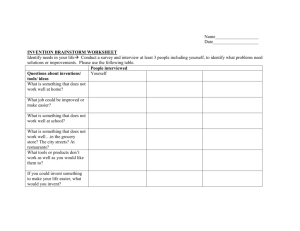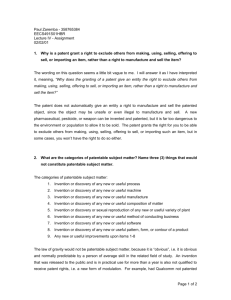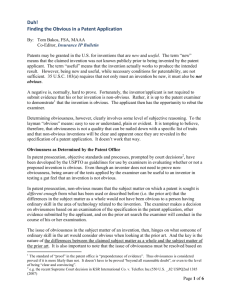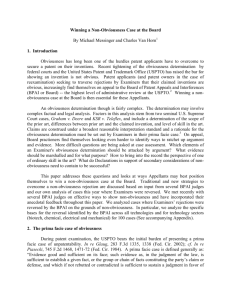Nonobviousness - An Essential Requirement for Patentability
advertisement
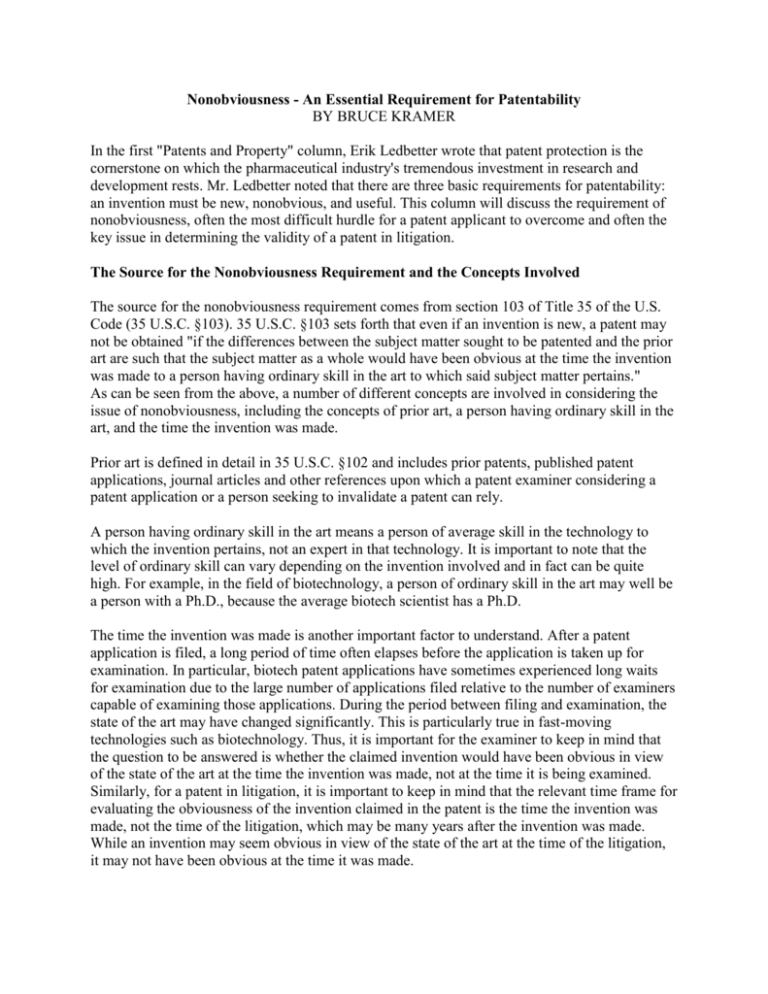
Nonobviousness - An Essential Requirement for Patentability BY BRUCE KRAMER In the first "Patents and Property" column, Erik Ledbetter wrote that patent protection is the cornerstone on which the pharmaceutical industry's tremendous investment in research and development rests. Mr. Ledbetter noted that there are three basic requirements for patentability: an invention must be new, nonobvious, and useful. This column will discuss the requirement of nonobviousness, often the most difficult hurdle for a patent applicant to overcome and often the key issue in determining the validity of a patent in litigation. The Source for the Nonobviousness Requirement and the Concepts Involved The source for the nonobviousness requirement comes from section 103 of Title 35 of the U.S. Code (35 U.S.C. §103). 35 U.S.C. §103 sets forth that even if an invention is new, a patent may not be obtained "if the differences between the subject matter sought to be patented and the prior art are such that the subject matter as a whole would have been obvious at the time the invention was made to a person having ordinary skill in the art to which said subject matter pertains." As can be seen from the above, a number of different concepts are involved in considering the issue of nonobviousness, including the concepts of prior art, a person having ordinary skill in the art, and the time the invention was made. Prior art is defined in detail in 35 U.S.C. §102 and includes prior patents, published patent applications, journal articles and other references upon which a patent examiner considering a patent application or a person seeking to invalidate a patent can rely. A person having ordinary skill in the art means a person of average skill in the technology to which the invention pertains, not an expert in that technology. It is important to note that the level of ordinary skill can vary depending on the invention involved and in fact can be quite high. For example, in the field of biotechnology, a person of ordinary skill in the art may well be a person with a Ph.D., because the average biotech scientist has a Ph.D. The time the invention was made is another important factor to understand. After a patent application is filed, a long period of time often elapses before the application is taken up for examination. In particular, biotech patent applications have sometimes experienced long waits for examination due to the large number of applications filed relative to the number of examiners capable of examining those applications. During the period between filing and examination, the state of the art may have changed significantly. This is particularly true in fast-moving technologies such as biotechnology. Thus, it is important for the examiner to keep in mind that the question to be answered is whether the claimed invention would have been obvious in view of the state of the art at the time the invention was made, not at the time it is being examined. Similarly, for a patent in litigation, it is important to keep in mind that the relevant time frame for evaluating the obviousness of the invention claimed in the patent is the time the invention was made, not the time of the litigation, which may be many years after the invention was made. While an invention may seem obvious in view of the state of the art at the time of the litigation, it may not have been obvious at the time it was made. Issues to Consider in an Obviousness Analysis Various aspects involved in the obviousness analysis were discussed by the Supreme Court in the seminal case Graham v. John Deere Co. (1). In Graham, the Supreme Court set forth three factual inquiries to be used in considering whether an invention is obvious or nonobvious: (i) determining the scope and content of the prior art; (ii) ascertaining the differences between the prior art and the claims at issue; and (iii) resolving the level of ordinary skill in the pertinent art. Also, secondary considerations such as unexpected results, commercial success, long-felt need, and the failure of others are to be considered in evaluating the obviousness or nonobviousness of an invention. Further, the principles set forth below must be followed when conducting an obviousness analysis: (a) the claimed invention must be considered as a whole; (b) the references must be considered as a whole and must suggest the desirability and thus the obviousness of making the combination; (c) the references must be viewed without the benefit of impermissible hindsight afforded by the claimed invention; and (d) reasonable expectation of success is the standard by which obviousness is determined (2). Obviousness Analysis at the Patent Office The Patent Office has incorporated these standards into the obviousness analysis carried out during the examination of a patent application. To reject a claimed invention as obvious, a patent examiner must establish what is called a prima facie case of obviousness. A prima facie case of obviousness is established when three basic criteria have been met. First, there must be some suggestion or motivation, either in the prior art cited by the examiner or in the knowledge generally available to one of ordinary skill in the art, to modify the reference or combine the references being relied upon to reject the claimed invention. Second, there must be a reasonable expectation of success. Third, the prior art reference or combination of references must teach or suggest all of the requirements of the claimed invention. As noted above, the suggestion or motivation to modify the prior art reference or combine the prior art references being relied upon to reject the claimed invention must be found either in the prior art or in the knowledge generally available to one of ordinary skill in the art; it cannot be based on hindsight benefiting from the disclosure of the claimed invention. In this regard, it should be noted that simply because prior art can be combined or modified does not mean that the combination or modification is obvious. Rather, the prior art must also suggest the desirability of making the combination or modification. For prior art to be modified or combined to reject a claimed invention, there must be a reasonable expectation of success. In the case In re Merck & Co., Inc. (3), a claimed invention directed to a method for treating depression with amitriptyline or nontoxic salts thereof was rejected as prima facie obvious over prior art disclosures that amitriptyline is a compound known to possess psychotropic properties and that imipramine is a structurally similar psychotropic compound known to possess antidepressive properties, combined with prior art suggesting that these compounds would be expected to have similar activity because the structural difference between the compounds involves a known bioisosteric replacement and because a research paper comparing pharmacological properties of these two compounds suggested clinical testing of amitriptyline as an antidepressant. The court sustained the rejection after determining that the teachings of the prior art provided a sufficient basis for a reasonable expectation of success. It is important to note that the time frame used to determine whether a proposed modification or combination of prior art has a reasonable expectation of success is the time the invention was made. In Ex parte Erlich (4), the Board of Appeals at the Patent Office found that although an earlier case reversed a rejection because of unpredictability in the field of monoclonal antibodies, "in this case at the time this invention was made, one of ordinary skill in the art would have been motivated to produce monoclonal antibodies specific for human fibroplast interferon using the method of [the prior art] with a reasonable expectation of success" (emphasis in the original). Responding to an Obviousness Rejection Once a patent examiner rejects a claimed invention by presenting what he or she considers to be a prima facie case of obviousness, a patent applicant must then present arguments showing that the examiner actually has not established a prima facie case of obviousness and/or present secondary evidence to rebut the examiner's prima facie case. For example, if the examiner has rejected the claimed invention based a combination of prior art references, the applicant could argue that one of ordinary skill in the art would not have been motivated to combine the references. Also, the applicant might be able to argue that even if one of ordinary skill in the art would have been motivated to make the combination proposed by the examiner, one still would not have arrived at the claimed invention, because the prior art combination does not teach or suggest all of the requirements of the claimed invention. In addition, or as an alternative to arguing that a prima facie case of obviousness has not been established, the applicant can present secondary evidence to rebut the prima facie case. For example, the applicant can present comparative experimentation demonstrating the unexpected superiority of the claimed invention. To be persuasive, the showing of unexpected superiority must be commensurate in scope with the claimed invention, and it must compare the claimed invention with the closest example disclosed in the prior art. For instance, if the key element in a process for making pharmaceutical composition involves adding a particular component to a mixture in an amount of 30 to 50 weight percent, and if the closest prior art includes examples in which that component is added in amounts of 10 and 20 weight percent, experiments should desirably be conducted comparing (A) 30, 40 and 50 weight percent invention examples (rather than just a 40 weight percent invention example, which would likely not be considered representative of the overall scope of the claimed invention) with (B) the 20 weight percent prior art example (since that is the prior art example which is closest to the claimed invention). If the claimed invention is shown to be unexpectedly superior, the obviousness rejection will be overcome. Conclusion From the above discussion, it can be seen that a number of different factors are involved in deciding whether or not an invention is obvious. The resolution of this issue plays a major role in determining whether a patent application will mature into a patent or whether a patent in suit will be found valid or invalid. Since pharmaceutical and biotech inventions can ring up many millions of dollars in sales per year, it is essential for a person involved in the patenting of those inventions to have a clear understanding of the issue of nonobviousness. References (1) Graham v. John Deere Co., 383 U.S. 1, 148 USPQ 459 (1966). (2) Hodosh v. Block Drug Co., Inc., 786 F.2d 1136, 229 USPQ 182 (Fed. Cir. 1986). (3) In re Merck & Co., Inc., 800 F.2d 1091, 235 USPQ 375 (Fed. Cir. 1986). (4) Ex parte Erlich, 3 USPQ2d 1011 (Bd. Pat. App. & Inter. 1986). Bruce Kramer is a shareholder in Sughrue Mion, PLLC, a Washington D.C. intellectual property law firm, and is a patent attorney registered to practice before the U.S. Patent & Trademark Office. The views expressed in this column are those of the author, and should not be attributed to Sughrue Mion, PLLC, or any of its clients.
![Introduction [max 1 pg]](http://s3.studylib.net/store/data/007168054_1-d63441680c3a2b0b41ae7f89ed2aefb8-300x300.png)




